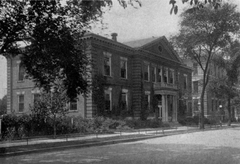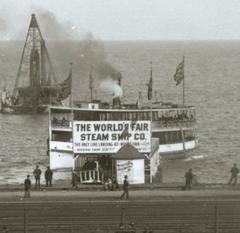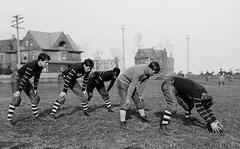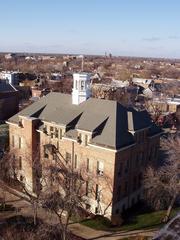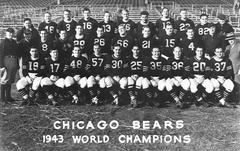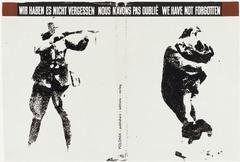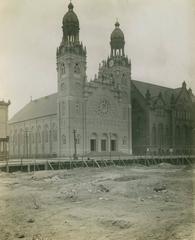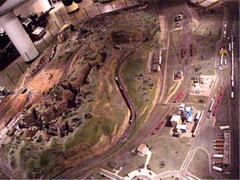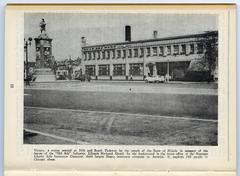
ग्रैंड सेंट्रल स्टेशन, शिकागो: आगंतुकों के लिए एक व्यापक मार्गदर्शिका
दिनांक: 03/07/2025
शिकागो में ग्रैंड सेंट्रल स्टेशन की विरासत की खोज के लिए यह एक निर्णायक संसाधन है। यह मार्गदर्शिका स्टेशन के उल्लेखनीय इतिहास, वास्तुशिल्प नवाचारों, सांस्कृतिक महत्व और आवश्यक आगंतुक जानकारी पर एक व्यापक नज़र डालती है। चाहे आप इतिहास के शौकीन हों या शिकागो की अपनी अगली यात्रा की योजना बना रहे हों, यह लेख आपको शहर के महान खोए हुए स्थलों में से एक के साथ गहराई से जुड़ने में मदद करेगा।
सामग्री की तालिका
- परिचय
- इतिहास और निर्माण
- वास्तुशिल्प विशिष्टता
- संचालन इतिहास और रेल सेवाएं
- पतन, विध्वंस और विरासत
- शिकागो के महान रेलवे टर्मिनल: तुलनात्मक संदर्भ
- सांस्कृतिक प्रभाव और उल्लेखनीय कार्यक्रम
- आगंतुक जानकारी: साइट विवरण और आस-पास के आकर्षण
- कैसे करें यात्रा: व्यावहारिक सुझाव, पहुंच और दौरे
- अक्सर पूछे जाने वाले प्रश्न (FAQs)
- दृश्य और मीडिया
- निष्कर्ष और सारांश
- स्रोत
परिचय
शिकागो में ग्रैंड सेंट्रल स्टेशन 19वीं सदी के अंत की रेलवे वास्तुकला और शहरी महत्वाकांक्षा की एक शानदार उपलब्धि थी। हालांकि 1971 में इसे ध्वस्त कर दिया गया था, इसकी कहानी तस्वीरों, ऐतिहासिक मार्करों और शहर की सांस्कृतिक स्मृति के माध्यम से जीवित है। यह मार्गदर्शिका ग्रैंड सेंट्रल के समृद्ध इतिहास, वास्तुशिल्प विरासत और इसके पूर्व स्थल और आस-पास के आकर्षणों को खोजने के लिए व्यावहारिक सलाह की पड़ताल करती है।
इतिहास और निर्माण
1890 में खोला गया, ग्रैंड सेंट्रल स्टेशन को प्रसिद्ध वास्तुकार सोलन स्पेंसर बेमन ने शिकागो और उत्तरी प्रशांत रेलमार्ग और विस्कॉन्सिन सेंट्रल रेलमार्ग के लिए डिजाइन किया था (आर्किसीक)। हैरिसन और वेल्स सड़कों पर रणनीतिक रूप से स्थित, स्टेशन ने मिडवेस्ट को पूर्वी संयुक्त राज्य अमेरिका से जोड़ा और शिकागो के तेजी से बढ़ते शहर और नदी के किनारे तक सीधी पहुंच प्रदान की (प्रिजर्वेशन शिकागो)।
इसके निर्माण ने युग के आशावाद और अमेरिका की रेल राजधानी के रूप में शिकागो के उद्भव को दर्शाया। स्टेशन शिकागो के डाउनटाउन में बनाया गया अंतिम प्रमुख यात्री टर्मिनल था, जो शहर की बढ़ती परिवहन आवश्यकताओं और इसकी वास्तुशिल्प आकांक्षाओं दोनों का प्रतीक था।
वास्तुशिल्प विशिष्टता
ग्रैंड सेंट्रल स्टेशन को इसकी विशिष्ट रोमनस्क पुनरुद्धार शैली और इंजीनियरिंग नवाचार के लिए मनाया गया था। हेडहाउस में एक स्मारकीय घड़ी टॉवर था, जो 247 फीट ऊपर उठता था और 11,000 पाउंड की घंटी रखता था (प्रिजर्वेशन शिकागो)। इसका स्व-समर्थित कांच और स्टील ट्रेन शेड - 555 फीट लंबा, 156 फीट चौड़ा और 78 फीट ऊंचा - एक तकनीकी चमत्कार था, जो पटरियों पर एक हवादार, अबाध स्थान बनाता था (आर्किसीक)।
आंतरिक भाग में संगमरमर प्रतीक्षालय, अलंकृत विवरण और उत्प्रवासी, उपनगरीय यात्रियों और शहर-बाध्य यात्रियों के लिए सोच-समझकर अलग किए गए स्थान थे। कैरिज ड्राइव और एक डीलक्स होटल का समावेश स्टेशन की भव्यता और कार्यक्षमता के मिश्रण को उजागर करता है (शिकैलोजी)।
संचालन इतिहास और रेल सेवाएं
शिकागो टर्मिनलों की तुलना में छोटा होने के बावजूद, ग्रैंड सेंट्रल स्टेशन ने शहर के रेल नेटवर्क में एक महत्वपूर्ण भूमिका निभाई। इसने बाल्टीमोर और ओहियो रेलमार्ग, पेरे मार्क्विट रेलमार्ग और शिकागो ग्रेट वेस्टर्न रेलवे सहित अन्य लोगों के लिए अंतिम बिंदु के रूप में कार्य किया (शिकैलोजी)। स्टेशन ऑल-पुलमैन “कैपिटल लिमिटेड” की मेजबानी के लिए प्रसिद्ध था, जो शिकागो को वाशिंगटन, डी.सी. से जोड़ता था, और राजनेताओं और गणमान्य व्यक्तियों द्वारा पसंद किया जाता था।
ग्रैंड सेंट्रल का डिजाइन चार अलग-अलग यात्री प्रवाहों—आगमन, प्रस्थान, उपनगरीय यात्री और उत्प्रवासी—को कुशलतापूर्वक प्रबंधित करता था, जिससे यह अपने चरम पर व्यवस्था और आधुनिकता का एक मॉडल बन गया।
पतन, विध्वंस और विरासत
20वीं सदी के मध्य में ऑटोमोबाइल और हवाई यात्रा के उदय ने यात्री रेल यात्रा में लगातार गिरावट लाई। ग्रैंड सेंट्रल स्टेशन के यातायात में कमी आई, और 8 नवंबर, 1969 तक, आखिरी ट्रेन रवाना हो गई थी (आर्किसीक)। 1971 में विध्वंस हुआ, भले ही संरक्षणवादियों के ठोस प्रयासों के बावजूद (प्रिजर्वेशन शिकागो)।
जबकि भौतिक संरचना चली गई है, ग्रैंड सेंट्रल की कहानी शिकागो के संरक्षण आंदोलन में एक स्पर्शरेखा है - इसके नुकसान ने यूनियन स्टेशन और रूकरी बिल्डिंग जैसी वास्तुशिल्प खजानों को बचाने के प्रयासों को बढ़ावा दिया। स्टेशन की स्मृति अभिलेखीय सामग्री, शहरी पैदल यात्राओं और शहर की सामूहिक चेतना के माध्यम से बनी हुई है।
शिकागो के महान रेलवे टर्मिनल: तुलनात्मक संदर्भ
ग्रैंड सेंट्रल स्टेशन, यूनियन स्टेशन, सेंट्रल स्टेशन और डियरबॉर्न स्टेशन सहित प्रमुख शिकागो टर्मिनलों के नेटवर्क का हिस्सा था। जबकि यूनियन स्टेशन ने कहीं अधिक यातायात संभाला और आज भी चालू है, ग्रैंड सेंट्रल अपनी इंजीनियरिंग नवाचारों और वास्तुशिल्प सुंदरता के लिए उल्लेखनीय था। इसके अपेक्षाकृत छोटे परिचालन जीवन ने रेलवे वास्तुकला और शहर नियोजन पर इसके स्थायी प्रभाव को कम करके आंका है (कर्बेड शिकागो)।
सांस्कृतिक प्रभाव और उल्लेखनीय कार्यक्रम
ट्रेनों और समय-सारणी से परे, ग्रैंड सेंट्रल स्टेशन एक जीवंत सामाजिक केंद्र था - जिसमें हस्तियों, प्रवासियों और रोजमर्रा के यात्रियों का स्वागत किया जाता था। इसकी घड़ी टॉवर शिकागो के क्षितिज का एक प्रतिष्ठित हिस्सा बन गई। स्टेशन ने साउथ लूप में वाणिज्यिक विकास को बढ़ावा देने में मदद की और कलाकारों और फोटोग्राफरों के लिए एक पसंदीदा विषय बना रहा। इसका विध्वंस अब ऐतिहासिक संरक्षण की आवश्यकता का एक शक्तिशाली प्रतीक है।
आगंतुक जानकारी: साइट विवरण और आस-पास के आकर्षण
साइट स्थान और संदर्भ
- स्थान: पहले हैरिसन और वेल्स सड़कों पर, साउथ लूप जिले में।
- आज का दिन: साइट अब अल्टा ग्रैंड सेंट्रल और साउथबैंक विकास का हिस्सा है। कोई मूल संरचनाएं नहीं बची हैं, लेकिन क्षेत्र में व्याख्यात्मक साइनेज हैं और ऐतिहासिक पैदल यात्राओं का एक हिस्सा है (शिकागो वाईआईएमबीवाई)।
पहुंच और परिवहन
- सार्वजनिक परिवहन: निकटतम सीटीए स्टेशन लासेल (ब्लू लाइन) और क्लिंटन (ब्लू और ग्रीन लाइन्स) हैं। कई बस मार्ग और डिवि बाइक स्टेशन आस-पास हैं (शिकागो विजिटर रिसोर्सेज चुनें)।
- पार्किंग: सीमित और महंगी; सार्वजनिक परिवहन और पैदल चलना अनुशंसित है (लोनली प्लैनेट)।
- पहुंच: आधुनिक क्षेत्र के विकास और पारगमन एडीए-अनुरूप हैं (एमट्रैक स्टेशन)।
क्या देखें और करें
-
व्याख्यात्मक मार्कर: साउथबैंक पार्क और रिवरवॉक में क्षेत्र के रेलवे इतिहास के बारे में साइनेज हैं।
-
आस-पास के आकर्षण:
- यूनियन स्टेशन (ऐतिहासिक, अभी भी चालू है, निर्देशित पर्यटन उपलब्ध हैं)
- विलिस टॉवर (स्काईडेक देखने का मंच)
- आर्ट इंस्टीट्यूट ऑफ शिकागो
- प्रिंटर्स रो (ऐतिहासिक जिला)
- शिकागो रिवरवॉक (भोजन, सार्वजनिक कला, नाव पर्यटन)
-
भोजन: वेस्ट लूप का रेस्तरां रो और प्रिंटर्स रो में विभिन्न प्रकार के पाक विकल्प प्रदान करते हैं, डीप-डिश पिज्जा से लेकर अंतर्राष्ट्रीय व्यंजनों तक।
कैसे करें यात्रा: व्यावहारिक सुझाव, पहुंच और दौरे
- आगंतुक घंटे: साइट एक खुला सार्वजनिक स्थान है जो वर्ष भर सुलभ है; किसी टिकट की आवश्यकता नहीं है।
- यात्रा का सबसे अच्छा समय: आरामदायक मौसम के लिए वसंत और पतझड़; सर्दियों में ठंड, गर्मियों में आर्द्र होता है।
- निर्देशित दौरे: स्थानीय ऐतिहासिक समाज और शिकागो आर्किटेक्चर सेंटर पैदल यात्राएं प्रदान करते हैं जिनमें ग्रैंड सेंट्रल साइट भी शामिल है (शिकागो आर्किटेक्चर टूर)।
- स्व-निर्देशित दौरे: शिकागो हिस्ट्री म्यूजियम और शिकागो आर्किटेक्चर सेंटर से डाउनलोड करने योग्य मानचित्र और ऑडियो गाइड उपलब्ध हैं।
- सुविधाएं: आस-पास के पार्कों और पारगमन हब में सार्वजनिक शौचालय उपलब्ध हैं।
अक्सर पूछे जाने वाले प्रश्न (FAQs)
प्रश्न: क्या मैं आज ग्रैंड सेंट्रल स्टेशन शिकागो जा सकता हूँ? A: मूल स्टेशन को 1971 में ध्वस्त कर दिया गया था। साइट एक बाहरी स्थान के रूप में व्याख्यात्मक मार्करों के साथ सुलभ है, लेकिन कोई इमारत नहीं बची है।
प्रश्न: क्या कोई टिकट या आगंतुक घंटे हैं? A: कोई टिकट या विशिष्ट घंटे नहीं हैं; साइट जनता के लिए खुली है।
प्रश्न: आस-पास क्या देखना और करना है? A: यूनियन स्टेशन, विलिस टॉवर, शिकागो रिवरवॉक और आर्ट इंस्टीट्यूट ऑफ शिकागो सभी पैदल दूरी पर हैं।
प्रश्न: क्या क्षेत्र सुलभ है? A: हां, आधुनिक फुटपाथ, एडीए-अनुरूप विकास और सार्वजनिक पारगमन पहुंच सुनिश्चित करते हैं।
प्रश्न: क्या ग्रैंड सेंट्रल स्टेशन साइट के निर्देशित दौरे हैं? A: हां, कई स्थानीय संगठनों द्वारा प्रदान की जाने वाली पैदल यात्राओं में साइट और इसके इतिहास को शामिल किया गया है।
दृश्य और मीडिया
अपनी यात्रा को बेहतर बनाने के लिए ऑनलाइन उपलब्ध ऐतिहासिक छवियों और डिजिटल पुनर्निर्माण को देखें। शिकागो हिस्ट्री म्यूजियम और स्थानीय अभिलेखागार स्टेशन की कहानी को जीवंत बनाने वाली तस्वीरें, नक्शे और आभासी दौरे प्रदान करते हैं। अपनी स्वयं की तस्वीरें साझा करते समय, इष्टतम जुड़ाव के लिए “ग्रैंड सेंट्रल स्टेशन साइट शिकागो” और “शिकागो रेलवे इतिहास” जैसे कीवर्ड का उपयोग करें।
निष्कर्ष और सारांश
ग्रैंड सेंट्रल स्टेशन शिकागो शहर के रेल के स्वर्ण युग और वास्तुशिल्प नवाचार का एक मार्मिक अनुस्मारक है। जबकि इमारत अब जीवित नहीं है, इसका प्रभाव शहर के शहरी ताने-बाने, संरक्षण प्रयासों और पैदल यात्राओं और अभिलेखीय प्रदर्शनियों के माध्यम से साझा की गई कहानियों में दिखाई देता है। पूर्व स्थल की खोज शिकागो के अतीत में एक अनूठी खिड़की प्रदान करती है, और आस-पास के आकर्षण एक पूर्ण अनुभव सुनिश्चित करते हैं।
अपनी यात्रा को और समृद्ध करने के लिए, क्यूरेटेड टूर और अंतर्दृष्टि के लिए ऑडियल ऐप डाउनलोड करें, और शिकागो की रेलवे विरासत पर संबंधित संसाधनों का अन्वेषण करें।
स्रोत
- ग्रैंड सेंट्रल स्टेशन शिकागो: इतिहास, आगंतुक जानकारी और विरासत (आर्किसीक)
- शिकागो के ग्रैंड सेंट्रल स्टेशन के इतिहास और विरासत की खोज: एक खोया हुआ वास्तुशिल्प चमत्कार (प्रिजर्वेशन शिकागो)
- शिकागो में ग्रैंड सेंट्रल स्टेशन साइट का दौरा: इतिहास, पर्यटन और आस-पास के आकर्षण (शिकागो विजिटर रिसोर्सेज चुनें)
- शिकागो में ऐतिहासिक ग्रैंड सेंट्रल स्टेशन साइट का दौरा: युक्तियाँ, आस-पास के आकर्षण और पहुंच (शिकागो वाईआईएमबीवाई)
- शिकागो वास्तुकला पर्यटन (टाइम आउट शिकागो यात्रा युक्तियाँ)
ऑडियल2024{‘date’: ‘03/07/2025’, ‘task’: {‘model’: ‘gpt-4.1-mini’, ‘query’: ‘Comprehensive guide to visiting Grand Central Station, Chicago, United States of America: history, significance, visitor tips, and everything tourists need to know for a memorable experience.’, ‘verbose’: False, ‘guidelines’: [“Keyword Research: Identify relevant keywords that potential visitors are likely to search for, such as ‘[Monument Name] visiting hours,’ ‘[Monument Name] tickets,’ and ‘[City] historical sites.’ Use these keywords strategically throughout the article, including in the title, headers, and body text, but avoid keyword stuffing.”, ‘Engaging and Informative Title: Craft a title that is both SEO-friendly and compelling to encourage clicks. Include the main keyword and make it clear what the article will cover.’, ‘Structured Content: Use headings (H1, H2, H3) to organize the content effectively. This helps with SEO and makes the article easier for readers to navigate. Include an introduction that hooks the reader, a detailed body that covers all relevant aspects, and a conclusion that summarizes the key points.’, ‘Comprehensive Coverage: Address common questions and topics of interest such as the history of the monument, its cultural significance, visitor information (e.g., ticket prices, opening hours), travel tips, nearby attractions, and accessibility. Include sections that might be unique to the monument, like special events, guided tours, and photographic spots.’, ‘Quality Content: Ensure the content is well-researched, accurate, and provides real value to readers. Use reliable sources and provide factual information. Write in a clear, engaging, and accessible style. Consider your audience and use language that is appropriate for those likely to visit the monument.’, ‘Visuals and Media: Incorporate high-quality images or videos of the monument. These should be optimized for the web (correct sizing, alt tags with keywords). Consider interactive elements like virtual tours or maps.’, ‘Internal and External Links: Include links to other related articles on your site to encourage deeper engagement (internal links). Link to official websites for the monument or credible sources for further reading (external links).’, ‘FAQ: Incorporate FAQ sections to target voice search queries and featured snippets’, ‘Visit and Stay Up to Date: End the article with a call to action, such as encouraging readers to download our mobile app Audiala, check out other related posts, or follow on social media for more updates.’], ‘max_sections’: 4, ‘publish_formats’: {‘pdf’: False, ‘docx’: False, ‘markdown’: True}, ‘follow_guidelines’: True}, ‘title’: ‘Grand Central Station, Chicago: A Comprehensive Visitor’s Guide’, ‘report’: ’# Grand Central Station Chicago: Visiting Hours, Tickets, and Historical Sites Guide\n\n#### Date: 03/07/2025\n\nWelcome to the definitive resource for discovering the legacy of Grand Central Station in Chicago. This guide offers a comprehensive look at the station’s remarkable history, architectural innovations, cultural significance, and essential visitor information. Whether you’re a history enthusiast or planning your next trip to Chicago, this article will help you connect deeply with one of the city’s great lost landmarks.\n\n---\n\n## Table of Contents\n\n- Introduction\n- History and Construction\n- Architectural Distinction\n- Operational History and Rail Services\n- Decline, Demolition, and Legacy\n- Chicago’s Great Railway Terminals: Comparative Context\n- Cultural Impact and Notable Events\n- Visitor Information: Site Details and Nearby Attractions\n- How to Visit: Practical Tips, Accessibility, and Tours\n- Frequently Asked Questions (FAQs)\n- Visuals and Media\n- Conclusion & Summary\n- Sources\n\n---\n\n## Introduction\n\nGrand Central Station in Chicago was a towering achievement of late 19th-century railway architecture and urban ambition. Though demolished in 1971, its story endures through photographs, historical markers, and the cultural memory of the city. This guide explores Grand Central’s rich history, architectural legacy, and practical advice for exploring its former site and nearby attractions.\n\n---\n\n## History and Construction\n\nOpened in 1890, Grand Central Station was designed by renowned architect Solon Spencer Beman for the Chicago and Northern Pacific Railroad and the Wisconsin Central Railroad (Archiseek). Strategically located at Harrison and Wells Streets, the station connected the Midwest with the eastern United States and provided a direct gateway into Chicago’s booming downtown and riverfront (Preservation Chicago).\n\nIts construction reflected the optimism of the era and Chicago’s emergence as America’s rail capital. The station was the last major passenger terminal built in downtown Chicago, symbolizing both the city’s growing transportation needs and its architectural aspirations.\n\n---\n\n## Architectural Distinction\n\nGrand Central Station was celebrated for its distinctive Romanesque Revival style and engineering innovation. The headhouse featured a monumental clock tower, rising 247 feet and housing an 11,000-pound bell (Preservation Chicago). Its self-supporting glass and steel train shed—measuring 555 feet long, 156 feet wide, and 78 feet high—was a technological marvel, creating an airy, unobstructed space over the tracks (Archiseek).\n\nThe interior boasted marble waiting rooms, ornate detailing, and thoughtfully separated areas for emigrants, suburban commuters, and city-bound travelers. The inclusion of a carriage drive and a deluxe hotel highlighted the station’s blend of grandeur and function (Chicagology).\n\n---\n\n## Operational History and Rail Services\n\nAlthough smaller than other Chicago terminals, Grand Central Station played a pivotal role in the city’s rail network. It served as the endpoint for the Baltimore & Ohio Railroad, Pere Marquette Railroad, and the Chicago Great Western Railway, among others (Chicagology). The station was renowned for hosting the all-Pullman “Capital Limited,” connecting Chicago to Washington, D.C., and was favored by politicians and dignitaries.\n\nGrand Central’s design efficiently managed four distinct passenger flows—arrivals, departures, suburban commuters, and emigrants—making it a model of order and modernity at its peak.\n\n---\n\n## Decline, Demolition, and Legacy\n\nThe rise of automobiles and air travel in the mid-20th century led to a steady decline in passenger rail travel. Grand Central Station’s traffic dwindled, and by November 8, 1969, the last train had departed (Archiseek). The station was demolished in 1971, despite concerted efforts by preservationists (Preservation Chicago).\n\nWhile the physical structure is gone, Grand Central’s story is a touchstone in Chicago’s preservation movement—its loss fueling efforts to protect architectural treasures like Union Station and the Rookery Building. The memory of the station endures through archival materials, urban walking tours, and the city’s collective consciousness.\n\n---\n\n## Chicago’s Great Railway Terminals: Comparative Context\n\nGrand Central Station was part of a network of major Chicago terminals, including Union Station, Central Station, and Dearborn Station. While Union Station handled far greater traffic and remains in operation today, Grand Central was notable for its engineering innovations and architectural elegance. Its relatively short operational life belies its lasting influence on railway architecture and city planning (Curbed Chicago).\n\n---\n\n## Cultural Impact and Notable Events\n\nBeyond trains and timetables, Grand Central Station was a vibrant social hub—hosting celebrities, immigrants, and everyday travelers. Its clock tower became an iconic part of Chicago’s skyline. The station helped spark commercial growth in the South Loop and remained a favorite subject for artists and photographers. Its demolition is now a powerful symbol of the need for historic preservation.\n\n---\n\n## Visitor Information: Site Details and Nearby Attractions\n\n### Site Location and Context\n\n- Location: Formerly at Harrison and Wells Streets, in the South Loop district.\n- Present Day: The site is now part of the Alta Grand Central and Southbank developments. No original structures remain, but the area features interpretive signage and forms part of historical walking tours (Chicago YIMBY).\n\n### Accessibility and Transportation\n\n- Public Transit: Closest CTA stations are LaSalle (Blue Line) and Clinton (Blue and Green Lines). Several bus routes and Divvy bike stations are nearby (Choose Chicago Visitor Resources).\n- Parking: Limited and expensive; public transit and walking are recommended (Lonely Planet).\n- Accessibility: Modern area developments and transit are ADA-compliant (Amtrak Station).\n\n### What to See and Do\n\n- Interpretive Markers: Southbank Park and the Riverwalk feature signage about the area’s railway history.\n- Nearby Attractions: \n - Union Station (historic, still operational, guided tours available)\n - Willis Tower (Skydeck viewing platform)\n - Art Institute of Chicago\n - Printers Row (historic district)\n - Chicago Riverwalk (dining, public art, boat tours)\n\n- Dining: West Loop’s Restaurant Row and Printers Row offer a variety of culinary options, from deep-dish pizza to international cuisine.\n\n---\n\n## How to Visit: Practical Tips, Accessibility, and Tours\n\n- Visiting Hours: The site is an open public space accessible year-round; no tickets required.\n- Best Time to Visit: Spring and fall for comfortable weather; winters are cold, summers humid.\n- Guided Tours: Local historical societies and the Chicago Architecture Center offer walking tours that include the Grand Central site (Chicago Architecture Tours).\n- Self-Guided Tours: Downloadable maps and audio guides are available from the Chicago History Museum and Chicago Architecture Center.\n- Amenities: Public restrooms are available in nearby parks and transit hubs.\n\n---\n\n## Frequently Asked Questions (FAQs)\n\nQ: Can I visit Grand Central Station Chicago today? \nA: The original station was demolished in 1971. The site is accessible as an outdoor space with interpretive markers, but no buildings remain.\n\nQ: Are there tickets or visiting hours? \nA: No tickets or specific hours; the site is open to the public.\n\nQ: What is nearby to see and do? \nA: Union Station, Willis Tower, Chicago Riverwalk, and the Art Institute of Chicago are all within walking distance.\n\nQ: Is the area accessible? \nA: Yes, modern sidewalks, ADA-compliant developments, and public transit ensure accessibility.\n\nQ: Are there guided tours of the Grand Central Station site? \nA: Yes, several walking tours offered by local organizations include the site and its history.\n\n---\n\n## Visuals and Media\n\nEnhance your visit by viewing historical images and digital reconstructions available online. The Chicago History Museum and local archives provide photographs, maps, and virtual tours that bring the station’s story to life. When sharing your own photos, use keywords such as “Grand Central Station site Chicago” and “Chicago railway history” for optimal engagement.\n\n---\n\n## Conclusion & Summary\n\nGrand Central Station Chicago stands as a poignant reminder of the city’s golden age of rail and architectural innovation. While the building itself no longer survives, its influence is visible in the city’s urban fabric, preservation efforts, and the stories shared through walking tours and archival exhibits. Exploring the former site offers a unique window into Chicago’s past, and nearby attractions ensure a fulfilling experience for visitors.\n\nTo further enrich your visit, download the Audiala app for curated tours and insights, and explore related resources on Chicago’s railway heritage.\n\n---\n\n## Sources\n\n- Grand Central Station Chicago: History, Visitor Information, and Legacy (Archiseek)\n- Exploring the History and Legacy of Chicago’s Grand Central Station: A Lost Architectural Marvel (Preservation Chicago)\n- Visiting the Grand Central Station Site in Chicago: History, Tours, and Nearby Attractions (Choose Chicago Visitor Resources)\n- Visiting the Historic Grand Central Station Site in Chicago: Tips, Nearby Attractions & Accessibility (Chicago YIMBY)\n- Chicago Architecture Tours (Time Out Chicago Travel Tips)\n\n---\n\n






























